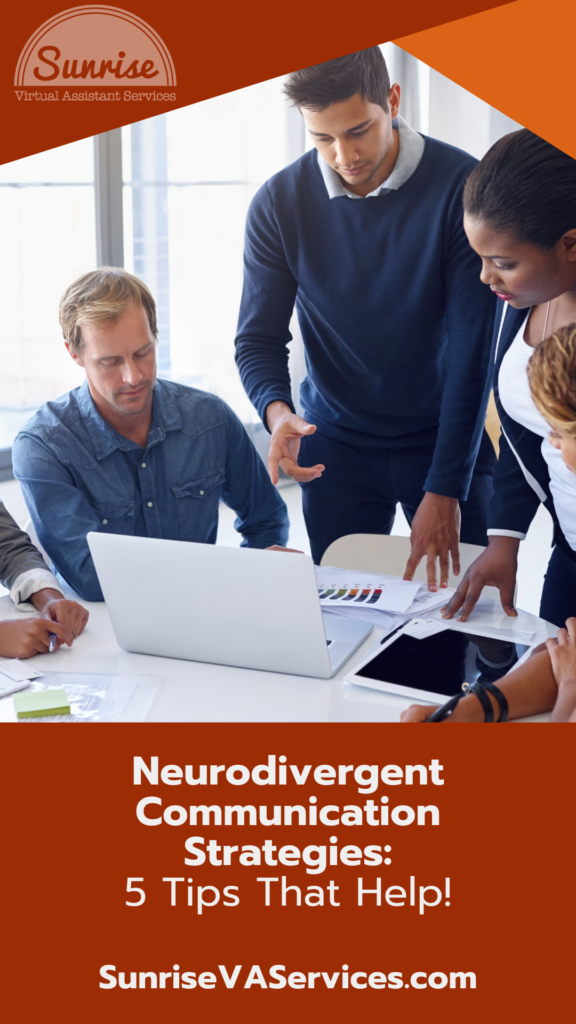Neurodivergent communication strategies are essential tools that foster inclusivity, learning, and respect, making interactions more meaningful and productive for everyone involved. These strategies are not just beneficial for neurodivergent individuals, but they enrich the communication landscape for all, promoting a deeper, more empathetic connection between individuals.
Navigating the landscape of neurodivergent communication can often feel like exploring complex, uncharted territory for many. The essence of effective communication lies in the exchange of information and the understanding and accommodation of each individual’s unique way of processing that information.
In this post, we’ll discuss five tips for improving neurodivergent communication in any setting. Whether you’re working from home or at a social gathering, these tips can create a more inclusive and understanding environment for everyone.
Understanding Neurodiversity
Before discussing specific communication strategies, it’s important to understand exactly what neurodiversity is. A neurodivergent condition refers to the natural variations in brain function among particular individuals.
This includes various conditions such as autism spectrum disorder (ASD), attention deficit hyperactivity disorder (ADHD), dyslexia, and more. It’s important to recognize that neurodiversity is not a disorder or something that needs to be “fixed” but simply different ways of processing information and experiencing the world.
This understanding allows neurotypical people to approach communication with neurodivergent people from a place of empathy and respect rather than judgment or assumptions.
Tip 1: Be Mindful of Nonverbal Cues
It is imperative to acknowledge that nonverbal social cues, such as tone of voice and body language, are fundamental in facilitating effective communication.
However, for neurodiverse people, these nonverbal communication cues may not always be accurate indicators of their thoughts or feelings. For example, someone with autism may struggle with reading or expressing appropriate facial expressions, while someone with ADHD may have difficulty maintaining eye contact.
Being mindful of these differences and not relying solely on nonverbal cues can help create a more inclusive communication environment. Instead, try to focus on the content of the conversation and use verbal cues, such as asking clarifying questions or restating essential points, to ensure that both parties are on the same page.
Tip 2: Questions Are Friends!
Posing questions is a simple yet powerful way to improve communication and understanding. This is especially true when communicating with individuals who are neurodivergent.
Asking open-ended questions, such as “Can you tell me more about that?” or “How does that make you feel?” allows the person to share their thoughts and feelings in their own words. It’s important to avoid leading questions or assumptions and to always listen actively without interrupting. This shows that you value the individual’s perspective and really are genuinely interested in understanding their point of view.
When engaging with neurodiverse individuals, it’s crucial to recognize that their questions often serve as a tool for better understanding rather than an act of defiance or challenge. Neurodiverse persons might ask more questions to clarify a specific topic, task, or instruction, as their processing and comprehension mechanisms may differ. Misinterpreting this curiosity as insubordination can hinder effective communication and create unnecessary barriers.
To foster a constructive dialogue, a neurotypical person should view these inquiries as an opportunity to clarify and elaborate further. This ensures that the message is received as intended and validates the individual’s effort to engage fully with the subject at hand.
Remember, the goal is to support mutual understanding and respect, turning moments of inquiry into springboards for more inclusive, and clear, communication.
Tip 3: Use Visual Aids
Visual aids, like pictures, diagrams, or written instructions, play a critical role in supporting individuals who face verbal communication challenges or auditory information processing.
These aids enhance comprehension and retention for those involved by offering a visual representation of the content being shared.
When interacting with neurodivergent individuals, it is recommended to integrate visual aids whenever feasible. Not only does this practice benefit neurodivergent individuals by facilitating better understanding, but it also enhances communication for everyone involved in the discussion.
Tip 4: Practice Patience and Flexibility
Neurodivergent individuals, such as those with ADHD, often navigate the world with a unique perspective. Their way of processing information and communicating may differ, necessitating understanding and support from individuals with more “neurotypical communication” styles.
When communicating with others, it is essential to practice patience and empathy, allowing them enough time to express their thoughts and feelings adequately. Creating an inclusive environment where they feel comfortable and safe to articulate themselves is crucial.
It’s also important to acknowledge that some individuals may experience severe anxiety, leading to delays in their responses, especially those with conditions like pathological demand avoidance.
Delivering communication in a caring and empathetic manner can help ease their anxiety and make them feel heard and understood. This approach applies to everyone, irrespective of their neurodiversity or neurotypicality.
Employing neurodivergent communication approaches, like utilizing visual supports or other tools, can significantly enhance anyone’s ability to engage and express themselves. Tailoring communication styles to accommodate their distinct needs and preferences, including providing ample time for reflection and response, can make a meaningful difference in their interactions and overall well-being.
Tip 5: Educate Yourself
As with any type of communication, knowledge is power. Take the time to educate yourself about neurodiversity and various neurodivergent conditions. This can help you better understand and support your neurodivergent employees, as well as recognize and challenge any biases or stereotypes you may have.
Additionally, don’t be afraid to ask the individual, or even a neurodivergent friend, about their specific needs and preferences regarding communication. Everyone is different, and taking the time to understand their perspective, individual needs, or even how they process information, can greatly improve communication and foster a more inclusive environment.
Neurodivergent communication strategies are important tools that can benefit everyone in any setting. By being mindful of nonverbal cues, asking questions, using visual aids, practicing patience and flexibility, and educating ourselves, we can create a more understanding, respectful, and inclusive communication landscape for all individuals.
Bonus Tip: Understand and Mitigate Sensory Overload
Sensory overload happens when one or more of the body’s senses get overstimulated by the environment.
For individuals who are neurodivergent, particularly those on the autism spectrum or with sensory processing disorder, sensory overload can be a common and distressing experience. Neurotypical individuals must recognize the signs of sensory overload—such as covering ears, restlessness, or withdrawal—and understand how to mitigate these situations.
Creating a sensory-friendly environment can help prevent sensory overload. This might involve reducing background noise, dimming bright lights, or providing quiet, low-stimulation spaces where individuals can retreat if they feel overwhelmed. Additionally, being mindful of using scents and textures in shared spaces can contribute to a more comfortable environment for those with sensory input sensitivities.
When planning events or meetings, consider providing detailed information in advance about what to expect regarding the social context and sensory environment. This empowers neurodivergent individuals to mentally prepare themselves or bring any personal sensory aids they might need.
For example, neurodiverse employees who cannot handle the sounds of office chatter while working, may bring noise-canceling headphones to a crowded work environment to better handle distractions and sensory overload.
Navigating Neurodiversity in Relationships
Couples in which one or both partners are neurodivergent can experience unique challenges and particular strengths in their relationship. Communication is critical, often requiring both partners to adopt tailored strategies that accommodate neurodiversity. It’s beneficial for neurodiverse couples to create a shared language or signals that succinctly convey needs or emotions, particularly during times of stress or misunderstanding.
Understanding each other’s sensory sensitivities can significantly enhance the relationship’s dynamics. For instance, recognizing if a partner is sensitive to loud noises or crowded spaces can inform how you plan activities or manage your home environment to be more accommodating.
Patience and an open-minded approach to problem-solving are key. What works for one couple might not work for another, so exploring unique solutions to challenges can be a bonding experience and a way to foster a deeper understanding of each other. Equally, celebrating the strengths that each partner brings to the relationship because of their neurodiversity can inspire mutual respect and admiration.
Remember, every relationship has its set of challenges and triumphs—neurodiverse couples are no different in this regard. The most crucial aspects are communication, understanding, and a willingness to adapt, which can cultivate a deeply rewarding partnership.
Final Thoughts on Neurodivergent Communication Strategies
In conclusion, understanding and implementing neurodivergent communication strategies is crucial for creating an inclusive and supportive environment.
By being mindful of nonverbal cues, utilizing questions effectively, employing visual aids, practicing patience and flexibility, and committing to continual education, we can foster a neurotypical world of communication that respects and values the diversity of thought and experience of people with neurological differences.
Navigating the neurodiverse world can be challenging, but you don’t have to do it alone. Sunrise Virtual Assistant Services specializes in supporting neurodiverse entrepreneurs and small business owners, offering tailored solutions that understand and respect your everyday life and unique way of interacting with the world.
Whether you need help organizing your schedule, managing communication, or strategizing your business approach, our team is trained and ready to assist you in harnessing your strengths and thriving in your endeavors.
We believe in the power of diversity and inclusion, not just as concepts but as actionable principles that drive success in the business world. Connect with Sunrise Virtual Assistant Services today and take the first step towards unlocking your full potential in an environment that genuinely understands and supports your unique needs.
Reach out to us, and together, we can create strategies and solutions that not only accommodate your neurodiversity but celebrate it.


